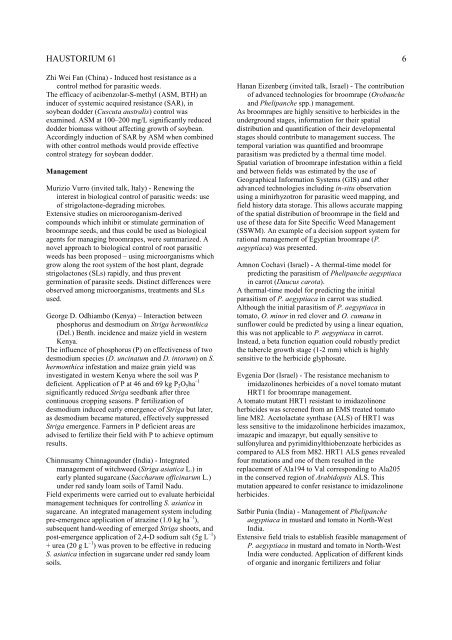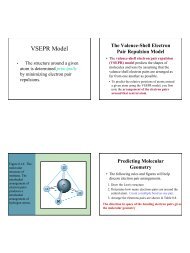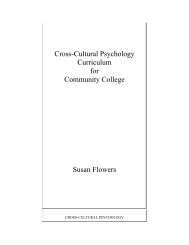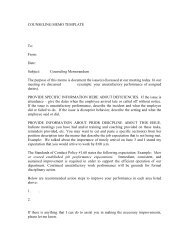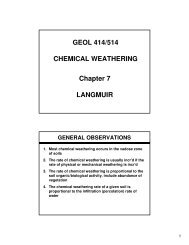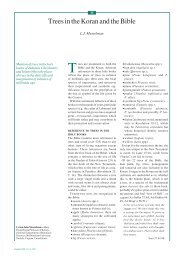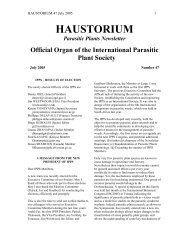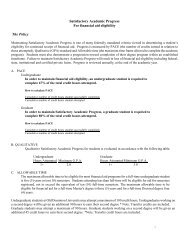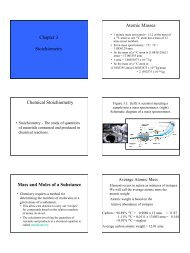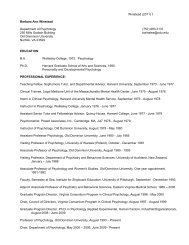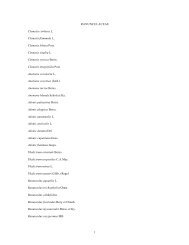HAUSTORIUM
HAUSTORIUM
HAUSTORIUM
You also want an ePaper? Increase the reach of your titles
YUMPU automatically turns print PDFs into web optimized ePapers that Google loves.
<strong>HAUSTORIUM</strong> 61 6<br />
Zhi Wei Fan (China) - Induced host resistance as a<br />
control method for parasitic weeds.<br />
The efficacy of acibenzolar-S-methyl (ASM, BTH) an<br />
inducer of systemic acquired resistance (SAR), in<br />
soybean dodder (Cuscuta australis) control was<br />
examined. ASM at 100–200 mg/L significantly reduced<br />
dodder biomass without affecting growth of soybean.<br />
Accordingly induction of SAR by ASM when combined<br />
with other control methods would provide effective<br />
control strategy for soybean dodder.<br />
Management<br />
Murizio Vurro (invited talk, Italy) - Renewing the<br />
interest in biological control of parasitic weeds: use<br />
of strigolactone-degrading microbes.<br />
Extensive studies on microoroganism-derived<br />
compounds which inhibit or stimulate germination of<br />
broomrape seeds, and thus could be used as biological<br />
agents for managing broomrapes, were summarized. A<br />
novel approach to biological control of root parasitic<br />
weeds has been proposed – using microorganisms which<br />
grow along the root system of the host plant, degrade<br />
strigolactones (SLs) rapidly, and thus prevent<br />
germination of parasite seeds. Distinct differences were<br />
observed among microorganisms, treatments and SLs<br />
used.<br />
George D. Odhiambo (Kenya) – Interaction between<br />
phosphorus and desmodium on Striga hermonthica<br />
(Del.) Benth. incidence and maize yield in western<br />
Kenya.<br />
The influence of phosphorus (P) on effectiveness of two<br />
desmodium species (D. uncinatum and D. intorum) on S.<br />
hermonthica infestation and maize grain yield was<br />
investigated in western Kenya where the soil was P<br />
deficient. Application of P at 46 and 69 kg P 2 O 5 ha –1<br />
significantly reduced Striga seedbank after three<br />
continuous cropping seasons. P fertilization of<br />
desmodium induced early emergence of Striga but later,<br />
as desmodium became matured, effectively suppressed<br />
Striga emergence. Farmers in P deficient areas are<br />
advised to fertilize their field with P to achieve optimum<br />
results.<br />
Chinnusamy Chinnagounder (India) - Integrated<br />
management of witchweed (Striga asiatica L.) in<br />
early planted sugarcane (Saccharum officinarum L.)<br />
under red sandy loam soils of Tamil Nadu.<br />
Field experiments were carried out to evaluate herbicidal<br />
management techniques for controlling S. asiatica in<br />
sugarcane. An integrated management system including<br />
pre-emergence application of atrazine (1.0 kg ha –1 ),<br />
subsequent hand-weeding of emerged Striga shoots, and<br />
post-emergence application of 2,4-D sodium salt (5g L –1 )<br />
+ urea (20 g L –1 ) was proven to be effective in reducing<br />
S. asiatica infection in sugarcane under red sandy loam<br />
soils.<br />
Hanan Eizenberg (invited talk, Israel) - The contribution<br />
of advanced technologies for broomrape (Orobanche<br />
and Phelipanche spp.) management.<br />
As broomrapes are highly sensitive to herbicides in the<br />
underground stages, information for their spatial<br />
distribution and quantification of their developmental<br />
stages should contribute to management success. The<br />
temporal variation was quantified and broomrape<br />
parasitism was predicted by a thermal time model.<br />
Spatial variation of broomrape infestation within a field<br />
and between fields was estimated by the use of<br />
Geographical Information Systems (GIS) and other<br />
advanced technologies including in-situ observation<br />
using a minirhyzotron for parasitic weed mapping, and<br />
field history data storage. This allows accurate mapping<br />
of the spatial distribution of broomrape in the field and<br />
use of these data for Site Specific Weed Management<br />
(SSWM). An example of a decision support system for<br />
rational management of Egyptian broomrape (P.<br />
aegyptiaca) was presented.<br />
Amnon Cochavi (Israel) - A thermal-time model for<br />
predicting the parasitism of Phelipanche aegyptiaca<br />
in carrot (Daucus carota).<br />
A thermal-time model for predicting the initial<br />
parasitism of P. aegyptiaca in carrot was studied.<br />
Although the initial parasitism of P. aegyptiaca in<br />
tomato, O. minor in red clover and O. cumana in<br />
sunflower could be predicted by using a linear equation,<br />
this was not applicable to P. aegyptiaca in carrot.<br />
Instead, a beta function equation could robustly predict<br />
the tubercle growth stage (1-2 mm) which is highly<br />
sensitive to the herbicide glyphosate.<br />
Evgenia Dor (Israel) - The resistance mechanism to<br />
imidazolinones herbicides of a novel tomato mutant<br />
HRT1 for broomrape management.<br />
A tomato mutant HRT1 resistant to imidazolinone<br />
herbicides was screened from an EMS treated tomato<br />
line M82. Acetolactate synthase (ALS) of HRT1 was<br />
less sensitive to the imidazolinone herbicides imazamox,<br />
imazapic and imazapyr, but equally sensitive to<br />
sulfonylurea and pyrimidinylthiobenzoate herbicides as<br />
compared to ALS from M82. HRT1 ALS genes revealed<br />
four mutations and one of them resulted in the<br />
replacement of Ala194 to Val corresponding to Ala205<br />
in the conserved region of Arabidopsis ALS. This<br />
mutation appeared to confer resistance to imidazolinone<br />
herbicides.<br />
Satbir Punia (India) - Management of Phelipanche<br />
aegyptiaca in mustard and tomato in North-West<br />
India.<br />
Extensive field trials to establish feasible management of<br />
P. aegyptiaca in mustard and tomato in North-West<br />
India were conducted. Application of different kinds<br />
of organic and inorganic fertilizers and foliar


